|
|
About Parthenon Frieze
| The Parthenon Frieze |
 |
|
The frieze of the Parthenon forms a continuous band with scenes in relief that encircles the upper part of the cella, the main temple, within the outer colonnade. The theme represented was the procession toward the Acropolis that took place during the Great Panathenaia, the festival in honour of the goddess Athena.
The frieze consisted of 115 blocks, it had a total length of 160 m. and was 1.02 m. high. Shown in the procession are some 378 human and divine figures and at least 220 animals, mainly horses. Groups of horses and chariots occupy most of the space on the frieze. The sacrificial procession follows, with animals and groups of men and women bringing ceremonial vessels and offerings. In the middle of the east end, above the entrance to the temple, is depicted the high point of the Panathenaia, this festival of many days duration. The procession ends with the giving of the peplos, the gift of the Athenian people to the cult statue of the goddess, the xoanon (ancient wooden statue) called diipetes (sent down from heaven). Left and right of the peplos scene sit the twelve Olympian Gods.
Of the entire frieze preserved today, 50 metres are in the Acropolis Museum, 80 metres in the British Museum, one block in the Louvre and several fragments are scattered in the museums of Palermo, the Vatican, Heidelberg, Vienna and Munich.
|

North frieze, block II. Acropolis Museum.
|
| The theme - The Panathenaia |
 |
|
The subject needed to cover so long and narrow a surface had to be one comprising many figures. A procession was therefore considered to be suitable.The ancient sources that refer to the frieze are all later than the Parthenon, beginning at the end of the 5th century B.C. At some points, the sources do not agree with the representations themselves. This disagreement has given rise to varying interpretations. Yet most scholars, with minor variations, agree that the theme of the Parthenon frieze is the procession of the Panathenaia, the culmination of the Great Panathenaia.
This was the most important of the Athenian festivals. It was celebrated every four years in the months of Hekatombaion (July-August) in honour of the guardian of the city, the goddess Athena. Tradition held that the festival was established in prehistoric times by Erichthonios, being known then as the Athenaia. Theseus was supposed to have reorganised it at the end of the Mycenaean period, and from then on the celebrations were called the Panathenaia. New changes were made by the tyrant Peisistratos in 566 B.C. The celebrations every four years (the Great Panathenaia) were held with such brilliance that during the 6th to the 4th century B.C. they were on a Panhellenic scale. The Lesser Panathenaia, held annually, were local in character. The festival of the Great Panathenaia included numerous ceremonies and sacrifices, of which the most striking was the Hekatombe (sacrifice of 100 bulls). Of great importance too were the equestrian, athletic and music contests. The ceremonies and games, which lasted from 4 to 12 days, reached their peak on the 28th of Hekatombaion, the day held to be Athena’s birthday. On this day the people of Athens gave their goddess a peplos woven with thread-of-gold by the Arrephoroi and the Ergastinai, maidens from prominent families in the service of the goddess.
The procession begins at the southwest corner of the temple and divides into two files, each of which moves toward the east. One goes along the south side, while the other traverses the west end and then moves along the north. Both end at the east, above the entrance to the temple. On the west and north sides, the figures move from right to left as seen by the viewer. Along the south, they move from left to right.
The actual procession began in the Kerameikos, at the Pompeion, a building with a spacious court, where the horsemen and their horses made ready for the parade, as is shown on the west end.
The peplos was brought in a splendid procession carried like a sail on a wheeled ship as far as the Areopagus and thereafter by hand.
The area along which the procession moved was known as the Dromos or Panathenaic Way, a road that cut diagonally across the Agora. Here the riders ran their horses and the chariots with their apobates raced. All this is shown on the parallel files of the north and south frieze. Then follow: political personages, musicians, thallophoroi (bearers of olive branches) and skaphephoroi (tray-bearers) along the south side, thallophoroi, musicians, hydriaphoroi (bearers of water-vessels) and skaphephoroi along the north side. Finally, at the east end of both sides, come the sacrificial animals. Scattered at intervals throughout the long procession are several officials.
The procession ends at the Acropolis, where the peplos was handed over to priests, who dressed the "xoanon" (the venerable wooden statue) of the goddess, initially in the «most ancient temple» (Archaios Naos), later on in the Erechtheion.
The giving of the peplos, in the presence of the gods and heroes, is depicted on the east end of the Parthenon frieze.
|

Athens in the 3rd century A.C. View from the northwest showing also the Panathenaic Way. Model at scale 1:2000. Centre for the Acropolis Studies.
|

The Panathenaic procession passing through the Athens Agora in front of the Odeion of Agrippa. Restored drawing by J. Travlos.
|
|
|
| Various interpretations |
 |
|
The problems of interpreting the scenes on the frieze are manifold indeed. It is evident that neither place nor time of the different scenes have been explained. Scenes of preparation that are found scattered at various points alternate with scenes of the procession moving. The horsemen of the west frieze must be at the Dipylon, the chariots and the horsemen who are galloping their horses cannot possibly on the uphill approach to the Acropolis. Yet the kanephoroi (basket-carriers) have already gone ahead and handed over their offerings.
Many questions remain to be answered. Since the archaic temple of Athena had been burned by the Persians, while the Erechtheion had not yet been built, to what extent is the theme focussed on the old or the new peplos, that covered the diipetes xoanon of the goddess, and was shown in the central scene? If the positioning of the gods and goddesses on the east frieze corresponds to the topographical location of the sanctuaries of Athens and the deities are in the area of the Peribolos (Precinct) of the Twelve Gods, then the King Archon and the priestess can place the peplos somewhere close, perhaps in the Royal Stoa in the Ancient Agora.
There are differences between the representations on the frieze and the descriptions of the procession in the ancient sources. For example, the representatives of the allies and colonies are omitted, as are also the skiaphoroi (sunshade-carriers) and diphrophoroi (stool-bearers) who were the daughters of metoikoi (settlers) and who followed the kanephoroi, (Athenian maidens who carried the offering baskets). The most significant omission, however, is that of the Panathenaic ship, on the mast of which the peplos was raised, like a sail. The ship, to be sure, was not taken up the Acropolis rock. It stopped somewhere near the Areopagus. From this point on, the peplos was carried by hand. This is what led the American archaeologist, S. Rotroff, to suggest that at the eastern parts of the long sides of the frieze are shown the two sections of the procession that mounted the Acropolis, whereas the ship remained at the Areopagus.
The Greek archaeologist, Chr. Kardara, presented a different interpretation according to which the frieze represents the original first procession with the dedication of the Panathenaic festival by Erechtheus, whom she identifies with Erichthonios, and recognises as the boy (35) in the east frieze. The figure (34) on the same side she identifies as Kekrops, figure (33) as Ge and the young maidens (31 and 32) as his daughters.
The theory of the English archaeologist J. Boardman is also of interest. He identifies the procession of 192 horsemen shown on the frieze as the procession of the 192 heroised dead of the battle of Marathon in the presence of gods and eponymous heroes. He excludes, however, the charioteers of the apobates’ chariots, although the charioteers are known to have shared victory with the apobates and for this reason received a prize.
The mixture of scenes in place and time, and the division of the procession into two parts has from time to time resulted in other hypotheses. The American archaeologist E. Harrison, for example, suggests that on three of the sides, the frieze represents the Panathenaic procession at different chronological periods. Thus the west frieze shows the procession in mythical times, the north in the archaic period, the south in the classical period. On the south frieze 60 riders are depicted who are divided into 10 groups of six each, 10 chariots, 10 bulls with their drivers and so on. The predominance of the number 10 on the south side is a reference to the ten tribes into which Kleisthenes divided the Athenian citizens for administrative and political purposes. On the north frieze the number 4 appears constantly, a reference to the 4 tribes of the archaic period, and the 12 chariots reflect the 12 phratriai (political sub-division of a tribe, a brotherhood).
The German archaeologist, E. Simon, has presented a similar theory, suggesting that the north procession refers to the archaic period, the south to classical times.
The Italian archaeologist, L. Beschi, as does E. Harrison, accepts the idea that the division of the procession into two sections is governed by separate arithmetical references. On the south side the repeated number 10 of the different groups corresponds to the 10 tribes. On the north side, the predominance of the number 4, with its multiples, agrees with the archaic division of the citizens into 4 tribes. In each section there are three themes: sacrificial procession on the Acropolis, chariot race and parade of horsemen at speeds varying according to the phase of the contest on the Dromos (Panathenaic Way) in the Ancient Agora. Thus rhythms, times and places vary. This is in opposition to the view that the frieze depicts a single procession from the Kerameikos to the Acropolis.
Even so, an interpretation of the representation as a unified whole draws support from a place that is not actual, but ideological, a cult area of votive offering. Even so, a view of the frieze as a unified whole would agree with the idea that the place represented is not actual, but ideological, an entire cult area in itself a votive offering. For the Parthenon is a building without an altar, containing a statue that is not a cult statue. It is a great votive offering and the frieze is the greatest votive relief in history, with important themes chosen from the ample programme of the Panathenaia. The chosen themes are alloted to two façades according to their origin, historical-religious and political. While they appear to form an antithesis, they come together in a wonderful way on the east end. Thus the frieze is a combination of earlier tradition and democratic revival at a rare moment of equilibrium.
|

The east frieze, block V. British Museum.
|
| Designing and carving |
 |
|
It is evident that the frieze was planned as a whole by the sculptor Pheidias, who was responsible for the supervision of the entire construction of the temple and its decoration, which was carried out by his students Agorakritos, Alkamenes, Kresilas and others. The frieze was made of blocks of various sizes. Its total length was 160 m., and its height 1.02 m. It went around the top of the walls of the main part of the temple within the outer collonade. The existence of regulae and guttae on the architrave is an indication that the original plan was to have triglyphs above. Thus it is likely that the decision to make the frieze was taken after the setting of the cella walls and the architrave blocks.
With the height of the frieze given, the artists were obliged to render the figures in different sizes and poses. Thus some are depicted on the ground, some ride, some stand, others leap into chariots, in such a way as to fit into the limited space of the frieze. Characteristic is the decrease in relative size of the horses and the greater size of the divinities who are shown seated on the east end of the building.
The scenes on some of the blocks are known from the drawings of J. Carrey (1674) and J. Stuart (1751). Other blocks have been entirely lost. The precise number of blocks along the sides is doubtful. It may be noted here that they are referred to as slabs in the bibliography, since Elgin sawed off the backs of the blocks to reduce their weight for shipping. In fact, as may be seen from the blocks in the Acropolis Museum, the frieze constituted a structural element of the cella wall and it was made of blocks 60 cm. thick, the outer surface of which was sculptured in relief that did not exceed 6 cm. There was a problem of visibility of the frieze because of its low relief and because it was set so high above the ground. This was resolved to a great extent by the use of colour, in particular the blue background, and especially by the deeper cutting of the upper in comparison to the lower part of the frieze, so that the sculptured surface inclines slightly toward the viewer.
The frieze was set in place between 443 and 438 B.C., that is between the completion of the metopes and the pediments. The north frieze is later than the east and west, but earlier than the south frieze. Most scholars believe that the frieze was carved after, rather than before, being set in place on the building. This is true of the long sides, but it does not hold for the west frieze, where each block has an independent representation and could have been carved beforehand.
|

The designing and carving of the frieze, drawing by M. Korres.
|
| History |
 |
|
In antiquity the frieze remained undisturbed in place on the monument for many years. Shortly after the middle of the third century A.D. there was a big fire in the Parthenon, but to what extent it damaged the frieze is unknown. When the great temple was converted into a church, probably between 450 and 500, the centre of the east pediment and part of the frieze of the east end were removed. Later on, perhaps during the 12th century, six blocks of the frieze were removed in order to make an equal number of windows, three on each long side of the building, which continued to function as a church.
In 1458, when the Turks seized Athens, the Parthenon became a mosque. In 1674, the artist Jacques Carrey accompanied C.F. Olier, Marquis de Nointel, French ambassador in Constantinople, to Athens where he made remarkably accurate drawings of the sculpture. Preserved today are his drawings of the east, west and parts of the long sides of the frieze.
The great destruction of the Parthenon occurred thirteen years later, in 1687, during the Turko-Venetian war and Morosini’s campaign in Athens. The explosion that occurred at that time destroyed a large part of the frieze of the long sides of the temple and caused irreparable damage to stones that remained in place as well as those that fell out. The way was thus open to looters. In the mid-eighteenth century the English architects, J. Stuart and N. Revett made for the first time accurate architectural drawings of the temple, the sculpture and also whatever of the frieze still remained in place.
During the first years of the 19th century, the British ambassador to the Ottoman Empire, Lord Elgin, violently removed from the ruined Parthenon as many sculptures as he could, including eighty metres of the frieze. The backs of the frieze blocks were sawn off in order to reduce their weight for shipping. These sculptures, known as the Elgin Marbles, are today in the British Museum, in London.
The last part of the frieze that remained in place was that on the west end, measuring approximately twenty metres. The rapid erosion of the marble in the open air and rain over the centuries made imperative the dismantling of this section in1993 and its transferal to the Acropolis Museum.
|

The Parthenon as a church, east end. Restored drawing by M. Korres.
|

The Parthenon as an Ottoman precinct during the 17th century. Dimetrical drawing by M. Korres.
|

The explosion of the Parthenon on September 26, 1687. Restored drawing by M. Korres.
|

Parthenon with the scaffolding for removing the sculpture. Drawing by Sir William Gell, 1801, London, British Museum.
|
|
|
| Conservation |
 |
|
One of the most important projects of the Acropolis Restoration Service was the conservation and restoration of the Parthenon west frieze, the last part of the frieze to remain in its original position, some 20 metres long.
The west frieze comprises 16 blocks, the first and second of which are in the British Museum. The frieze blocks have suffered mechanical stress and damage, from the passage of 2500 years, from the failure of previous interventions and from atmospheric pollution.
In 1978 the frieze was sheltered in an effort to avoid acidic attack on the sculptured surface and the washing out of the gypsum formed. The result of this choice was the covering of the surface of the blocks with deposits of soot and black incrustation. In 1992-93 the frieze blocks were dismantled and transferred to a specially constructed laboratory in the Acropolis Museum, so that their conservation could begin.
Conservation of the blocks began in 1999 and was successfully completed in 2005. Initially the work was focussed on structural restoration of the blocks, in the course of which fragments were joined, the surfaces were consolidated and the mortars and pins of earlier interventions were removed. The surface was then cleaned of soot deposits and the black incrustation. Following a comparative study of four cleaning methods (microblasting, absorptive poultices, gypsum inversion and laser), cleaning by laser proved to be the most effective in all cases of deposits and substrates (monochromatic surface layers and marble). The cleaning system was designed and developed by the Acropolis Restoration Service in collaboration with the Institute of Electronical Structure and Laser of the Technical and Research Foundation, Crete. This is the laser type Q-switched Nd: YAG. The prototype system can emit both at two wave lengths (infrared 1064nm and ultraviolet 355nm), individually or simultaneously.
The blocks of the west frieze are now on exhibition in the Acropolis Museum. Copies of artificial stone have been set in their place on the monument.
|

West frieze, block XII before and after the conservation works.
|
© 2009 Ministry of Culture – Acropolis Restoration Service – First Ephorate of Prehistoric and Classical Antiquities – Department of Information and Education
© 2009 National Documentation Centre-National Hellenic Research Foundation
Reprinting of all or part, republication or reproduction of photographs and/or text in any form whatsoever without written permission of the holders of the copyright is strictly forbidden.
|




















